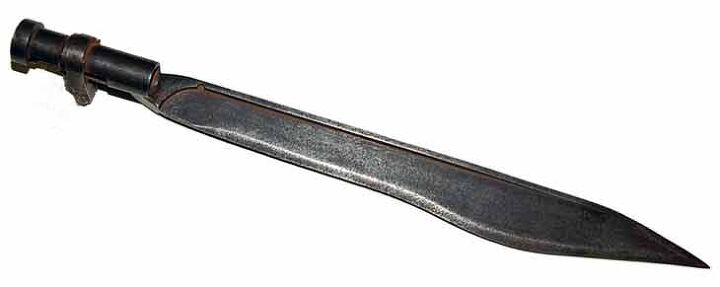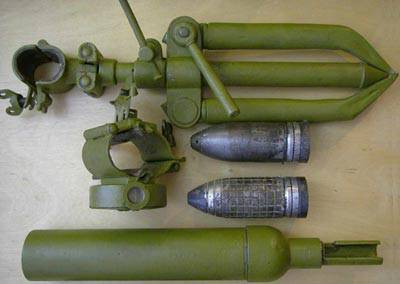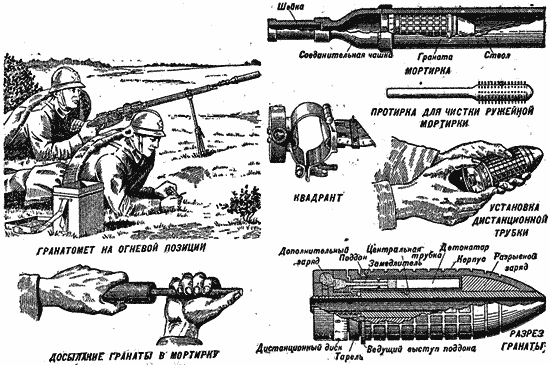It is not a secret that Mosin-Nagant rifles are one of the most popular military surplus rifles in the USA. They are relatively affordable, .30 cal reliable rifles just to mention a few reasons of their popularity. The information about the history and various modifications of these rifles is readily available on the internet, so I’ll skip that basic information. The subject of this article are the strangest and rarest Mosin-Nagant rifles and accessories, which were designed until the end of WW2. This time period includes the active duty era of the rifle when it was in service in many countries, most notably in Russian Empire and Soviet Union. So below is the list of mentioned rifles and accessories:
1) Kulakov Automatic Grenade Launcher

This 5 shot revolver grenade launcher was designed by captain Kulakov during WW2. It is based on Mosin-Nagant action and uses blank cartridges to launch the grenades. The 5 shot cylinder has a front loading gate where 44.15mm grenades are loaded from.
The cylinder rotation was automatic. Before the shot, rifle’s chamber, cylinder and the launcher’s barrel rest on each other, thus ensuring the obturation of the system. The Kulakov launcher used a mechanism somewhat similar to Bang rifle. After the shot, gasses following the grenade were trapped in a chamber around the muzzle and forced the barrel to move forward. The forward motion of the barrel broke the obturation and forced the cylinder to rotate. Then the recoil spring forced the barrel back. So now the shooter had a fresh grenade ready to be shot and all he needed to do is to work the rifle’s action to load another blank 7.62x54R cartridge. The launcher also had a large recoil pad and a pistol grip.
The Kulakov launcher had a number of problems during testing and was not advised for further development. It failed to meet all requirements and was never adopted. It was heavy (33 lbs unloaded), complicated to use and maintain, hard to manufacture and hard to manipulate.
2) Experimental Bayonet

Although this bayonet is referred to as an experimental one, it was produced and issued to troops in small quantities. This bayonet was designed in 1905 and arguably was issued even during the Russo-Japanese war (1904-1905). The bayonet mounts on Mosin-Nagant rifles exactly same way as the conventional one. It has an overall length of 15″ with 12″ blade. At its narrowest point width of the blade is 1″, and in widest point, it’s 1,5″. If you want to find one of these bayonets for your collection, you should be careful. According to reports of several Russian collectors, the market is flooded with fake replicas of this bayonet.
3) Wire Cutter Bayonet

During WW1 it became obvious that troops need a relatively compact mean to cut the barbed wire obstacles. Sapper tools were not issued widely and overcoming barbed wires was a disastrous part of any offensive causing numerous casualties. So Russia developed a special wire cutting device which was attached to the “experimental bayonet” and made it possible for any soldier to cut the wire obstacles.

During its testing, it proved to be pretty effective. Soldiers could cut the wires not exposing themselves to enemy fire. A soldier had to catch the wire between the two blades and push the rifle forward thus forcing the diamond shaped mechanism to work the wire cutter and cut the wire. The device had a spring loaded mechanism, which allowed it to retract back once the pressure was no longer applied.
4) Dyakonov Grenade Launcher

This muzzle grenade launcher was developed during WW1 by Russian captain Mikhail Dyakonov. It was adopted in December 1916 with an initial order of 40,000 launchers and 6,125,000 grenades. This order was not fully supplied due to the end of WW1. However, Red Army later kept equipping its troops with the Dyakonov grenade launchers.

Dyakonov’s system consisted of a muzzle mounted launcher, grenades, a sighting device and a bipod. The launcher had three riflings which engaged the corresponding lugs on the grenades. The 41mm grenades themselves were launched in a pretty unique way. Many rifle grenades are launched using blank ammunition. But the Dyakonov launcher used live ammunition! The grenade had a hollow tube across its length which allowed the bullet to escape through the body of the grenade. The gasses following the bullet then launched the grenade. The launcher could be used for engaging targets located at 150 to 850 meters.

The sighting device clamped on the left side of Mosin-Nagant rifles, right behind the rear sight. Bipod was adjustable and also clamped on the rifle.
5) Naiman Hand Mortar (RMN-50)

RMN-50 is actually designated as a hand mortar rather than a grenade launcher. It was designed during WW2 by a man named I.M. Naiman. They used Mosin-Nagant rifles with damaged barrels. The non-usable rifle barrel was cut leaving only the chamber and very little of the rifled portion. Then a Model 1938/40 50mm mortar smoothbore barrel was attached to the rifle. The result was a relatively compact and powerful mortar/grenade launcher.

RMN-50 fired 50mm mortar shells without the baseline charge, using blank 7.62x54R cartridges to propel the shells. Although the distance was sacrificed compared to the conventional mortar, it still was effective. They also used standard Mosin-Nagant sights mounted on the mortar barrel. Because there is very little information available about this gun, we can only guess if it was possible to fire from shoulder or soldiers had to put the stock on the ground. There are several surviving samples of RMN-50 in various museums.
6)BraMit Suppressor

“Mitin Brothers” (BraMit) is perhaps the most prominent name associated with Russian silencer design. They had several suppressor models designed back in 1930s for different guns. The most successful of their suppressors was one adopted in 1940 for Model 91/30 Mosin-Nagant rifles. It was issued to special operations and reconnaissance units.

BraMit suppressor had an external tube of 1.26″x5.8″ (32x147mm) dimensions. It had two chambers with rubber wipes instead of baffles. The first chamber had a cone shaped insert to redirect the gasses escaping ahead of the bullet. Each chamber also had a small (1mm) hole on the outer tube to vent the trapped gasses out of the suppressor. In order to work effectively, BraMit suppressors were designed to be used with special low charge subsonic cartridges. Those cartridges had bullets fully painted in green color. Due to the reduced power cartridge, the effective range of the rifle was about 200 meters.
7) Modrakh Device

This is the Russian version of the periscope rifle conversion designed by Lt. Colonel Modrakh. During WW1 many countries experimented and used this kind of trench rifles. The idea behind it is to attach a periscope to the rifle and link the trigger so that the shooter could aim and make a shot without exposing himself to the enemy fire. This device proved to be simple and easy to manufacture and actually was issued to the Russian troops. It used a very simple non-magnified periscope.
Of course, there can be more Mosin-Nagant versions which could make into this list. So if you know about something worthy (in terms of the subject of this article), which I missed to include, feel free to tell about and show in the comments. I hope you enjoyed this article!
Sources:
www.zonwar.ru
www.topwar.ru
www.dogswar.ru
www.smallarms.ru
 Your Privacy Choices
Your Privacy Choices
